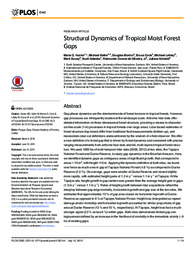Structural dynamics of tropical moist forest gaps.
Structural dynamics of tropical moist forest gaps.
Autoria: HUNTER, M. O.; KELLE, M.; MORTON, D.; COOK, B.; LEFSKY, M.; DUCEY, M.; SALESKA, S.; OLIVEIRA JUNIOR, R. C. de; SCHIETTI, J.
Resumo: Gap phase dynamics are the dominant mode of forest turnover in tropical forests. However, gap processes are infrequently studied at the landscape scale. Airborne lidar data offer detailed information on three-dimensional forest structure, providing a means to characterize fine-scale (1 m) processes in tropical forests over large areas. Lidar-based estimates of forest structure (top down) differ from traditional field measurements (bottom up), and necessitate clear-cut definitions unencumbered by the wisdom of a field observer.We offer a new definition of a forest gap that is driven by forest dynamics and consistent with precise ranging measurements from airborne lidar data and tall, multi-layered tropical forest structure. We used 1000 ha of multi-temporal lidar data (2008, 2012) at two sites, the Tapajos National Forest and Ducke Reserve, to study gap dynamics in the Brazilian Amazon. Here, we identified dynamic gaps as contiguous areas of significant growth, that correspond to areas > 10 m2, with height <10 m. Applying the dynamic definition at both sites, we found over twice as much area in gap at Tapajos National Forest (4.8 %) as compared to Ducke Reserve (2.0 %). On average, gaps were smaller at Ducke Reserve and closed slightly more rapidly, with estimated height gains of 1.2 m y-1 versus 1.1 m y-1 at Tapajos. At the Tapajos site, height growth in gap centers was greater than the average height gain in gaps (1.3 m y-1 versus 1.1 m y-1). Rates of height growth between lidar acquisitions reflect the interplay between gap edge mortality, horizontal ingrowth and gap size at the two sites. We estimated that approximately 10%of gap area closed via horizontal ingrowth at Ducke Reserve as opposed to 6 %at Tapajos National Forest. Height loss (interpreted as repeat damage and/or mortality) and horizontal ingrowth accounted for similar proportions of gap area at Ducke Reserve (13% and 10 %, respectively). At Tapajos, height loss had a much stronger signal (23 %versus 6 %) within gaps. Both sites demonstrate limited gap contagiousness defined by an increase in the likelihood of mortality in the immediate vicinity (~6 m) of existing gaps.
Ano de publicação: 2015
Tipo de publicação: Artigo de periódico
Unidade: Embrapa Amazônia Oriental
Palavras-chave: Landscape scale
Observações
1 - Por padrão são exibidas publicações dos últimos 20 anos. Para encontrar publicações mais antigas, configure o filtro ano de publicação, colocando o ano a partir do qual você deseja encontrar publicações. O filtro está na coluna da esquerda na busca acima.
2 - Para ler algumas publicações da Embrapa (apenas as que estão em formato ePub), é necessário ter, no celular ou computador, um desses softwares gratuitos. Sistemas Android: Google Play Livros; IOS: iBooks; Windows e Linux: software Calibre.
Acesse outras publicações
Acesse a Base de Dados da Pesquisa Agropecuária (BDPA) para consultar o acervo completo das bibliotecas da Embrapa.

